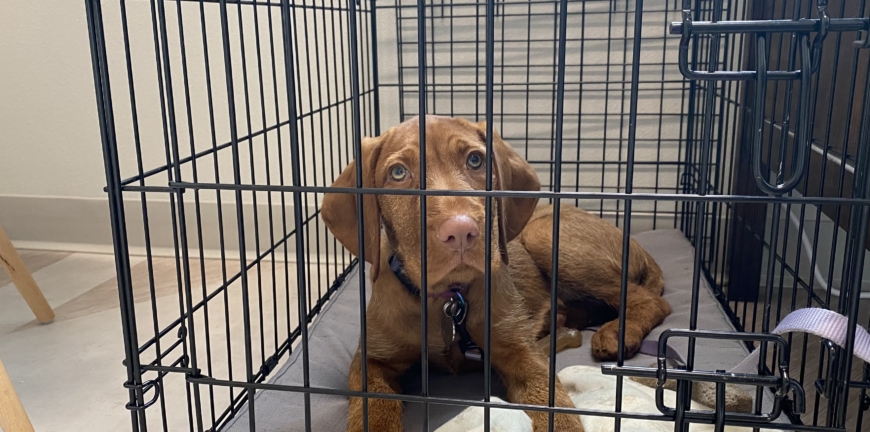April 13, 2023

Crate Training
My family and I recently got a puppy. I knew that crate training would be important for many reasons, but I also knew it would require patience and effort.
The first night we put her in the crate for bedtime she howled. That only lasted about 20 minutes so I figured that wasn’t so bad. Maybe this will be smooth sailing. But then she was up almost every hour whining. Despite trading who got up with her, my husband and I did not sleep much that night.
The second night, it took a lot of determination not to just let her sleep on her bed. She looked so peaceful there and we didn’t want to disturb her. But then I reminded myself why I want to crate train her. There are so many benefits to having a dog that is crate trained.
Benefits
The first is that it can help with potty training. In a proper size crate, most dogs will not go to the bathroom. They will typically indicate when they need to go to the bathroom. Sometimes this is with a whine, other times they may scratch at the door. If a crate is too big or your dog has a medical issue, such as diarrhea or a urinary tract infection, then they could have accidents in the crate.
The crate can provide a safe place for your dog to be when you’re not home or you’re busy. A crate is a controlled environment where your dog has access to only the things you have placed in the crate. You can provide safe toys for them to chew on and they can’t get into things like garbage or other harmful items.
The crate can provide a safe place for them to ride in on car trips or even an unforeseen plane ride. Some dogs will move around a lot in the car, which can be unsafe for them and their owners. Crates can also protect dogs if in a car accident. Although it may not be in the plans now, a plane ride is another time that dogs often need to be in a crate.
Crates can also be a safe space for your dog. They usually feel at home in the crate and it can be comforting if you take it with you on trips, when you move or if there are stressful times for your dog.
Some tips to consider if crate training
- Type of crate: From plastic, to wire frame, to fabric, there are many different types of crates. Your dog may prefer one over the other. The important thing is that they cannot hurt themselves in the crate, they cannot escape the crate or destroy it.
- Supervision during initial training: When you first start crate training it is best to be nearby so you know how your dog will react. If they are extremely stressed in the crate then start with short lengths of time to keep it positive.
- Amount of time in the crate: Once your dog is tolerating the crate well, they should still not stay in it for longer than 4 hours during the day or 8-10 hours overnight without being let out to go to the bathroom.
- When to take your dog or puppy out of the crate: Your dog should only be taken out of the crate when they are quiet. Wait until they stop whining, barking or howling (even if it’s just for a second). If you take your dog out of the crate while they are whining, it reinforces this behavior & they will likely continue to do it in order to get your attention or get out of the crate. If you think your dog needs to go to the bathroom, then it is OK to take them out of the crate when they are whining as long as you put them directly back into the crate once you let them out to the bathroom.
- Keep the crate a positive and safe environment. Giving your dog treats or special toys for going into the crate can encourage them. If it’s not bedtime, providing adequate things to chew on, treats and a proper temperature will improve your dogs experience in the crate.
Although crate training is not always smooth or easy, it is very helpful and beneficial for your dog in the long run. There are still times when I put my puppy in the crate and she whines or barks a bit, but I know she is safe in there and these instances are happening less frequently the more we use the crate.